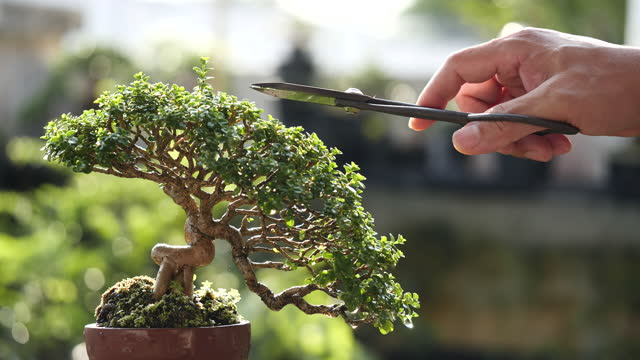What is Bonsai
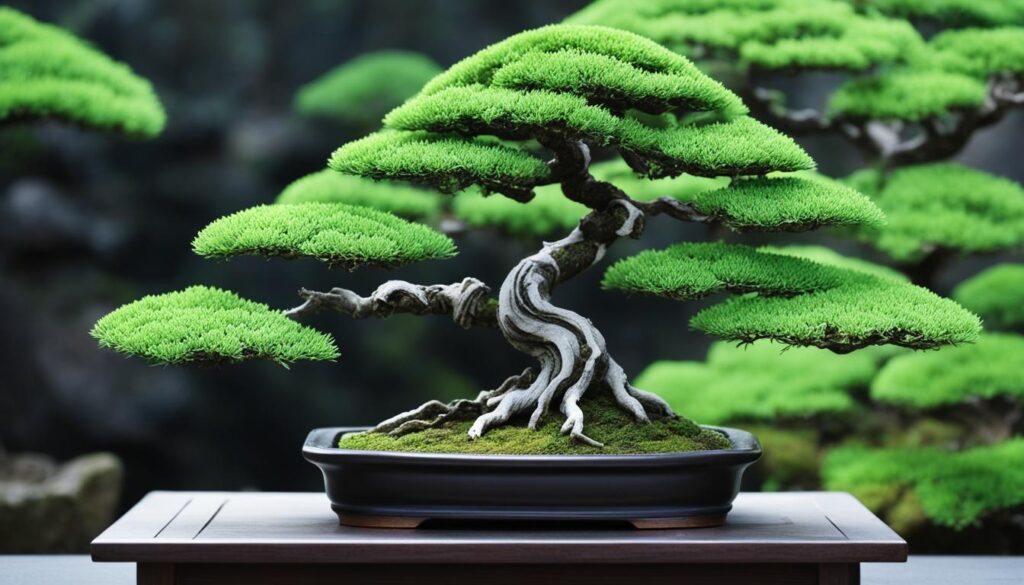
Bonsai is an ancient art form that involves cultivating and pruning trees and plants in containers, creating intricate miniature landscapes. Originating in China over 2,300 years ago, bonsai later gained popularity in Japan among Zen Buddhists as a mindful practice. The word “bonsai” itself means “tray planting” in Japanese, reflecting the unique approach of growing trees in shallow pots to maintain their small size.
Bonsai trees are characterized by their distinct small size and meticulously pruned branches and roots. Through careful training and wiring, bonsai artists shape these trees to resemble their larger counterparts while capturing the essence of their natural forms. The miniature size of bonsai offers a unique perspective on the beauty and resilience of nature, making it a captivating art form.
Characteristics and Traits
The art of bonsai requires careful attention to its unique characteristics and traits. Some key features of bonsai include:
- Small size: Bonsai trees are intentionally kept small through continuous pruning and root control. This creates a sense of harmony and balance with nature.
- Elegance: Bonsai trees exude an air of elegance and sophistication, capturing the serene beauty of mature trees in a compact form.
- Patience and discipline: Growing and maintaining bonsai requires patience, discipline, and a deep understanding of horticulture. It is a practice that encourages mindfulness and a connection with nature.
- Aging and maturity: Bonsai trees, like their larger counterparts, exhibit signs of aging and maturity such as gnarled trunks, weathered bark, and twisted branches. These characteristics add to the charm and authenticity of the miniature tree.
Types of Trees Suitable for Bonsai
Various tree species are suitable for bonsai cultivation, each offering its own unique characteristics and requirements. Some popular types of trees used for bonsai include:
| Tree Species | Characteristics | Suitable Climate |
|---|---|---|
| Junipers | Evergreen foliage, resilient and adaptable. | Moderate to cool climates. |
| Maples | Colorful foliage, beautiful branching patterns. | Temperate climates. |
| Pines | Long needles, rugged appearance. | Various climates and species-dependent. |
| Cherry and Plum | Fruit-bearing, fragrant blossoms. | Moderate to warm climates. |
History and Origin of Bonsai

The practice of growing bonsai trees has a rich history that dates back over 2,300 years. Its roots can be traced back to ancient China, where it was known as “pun-jai” and was primarily practiced by aristocrats. These intricately cultivated miniature trees were considered a symbol of prestige and wealth.
However, it was in Japan where bonsai truly flourished as an art form. During the Edo period, Zen Buddhists adopted bonsai and incorporated it into their meditative practices. The meticulous care and attention given to these miniature trees were believed to inspire tranquility and contemplation.
As the art of bonsai evolved in Japan, it became popular among commoners as well. Bonsai culture expanded with the publication of scholarly books on growing techniques and the staging of large-scale bonsai exhibitions, captivating audiences with the beauty and artistry of these miniature natural wonders.
Today, bonsai is deeply ingrained in Japanese culture and is considered an intricate part of the country’s artistic tradition. It has gained international recognition as a symbol of Japanese aesthetics and has inspired countless enthusiasts around the world to explore the art of growing and shaping these living sculptures.
How old do bonsai trees live
Bonsai trees can live for many decades, with some species having lifespans ranging from 40 to over 1,000 years, depending on the species and care provided. For example, Juniper bonsai trees typically live for about 50-70 years, while Ficus and Pine bonsai can reach 100-200 years or more under optimal conditions.
Must read: 7 Oldest Bonsai Trees In The World
Cultural Significance of Bonsai
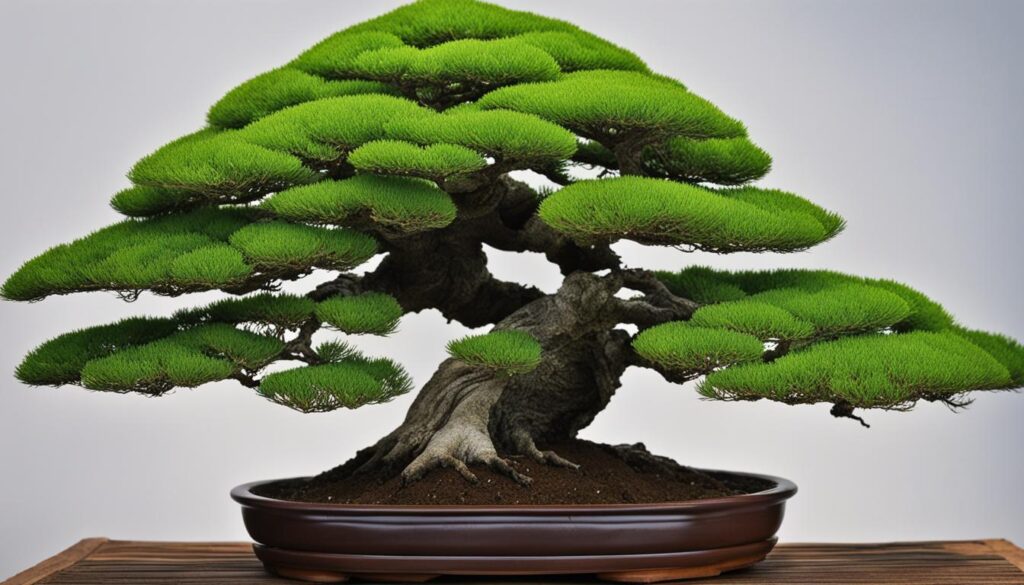
Bonsai holds great cultural significance in Japanese society. It is seen as an expression of the Japanese aesthetic and their respect for nature. Bonsai is not just a hobby, but also an art form that requires patience, skill, and an understanding of nature.
Bonsai trees are often displayed in special tokonoma alcoves in Japanese homes, where they are admired for their beauty and symbolism. The meticulous craftsmanship that goes into shaping and maintaining a bonsai tree reflects the attention to detail and discipline that are deeply valued in Japanese culture.
Bonsai carries a spiritual essence as well, symbolizing harmony, balance, and the fleeting beauty of life. The meditative practice of caring for bonsai trees encourages mindfulness and a connection with nature.
Bonsai has not only captivated the Japanese but has also gained international recognition as a symbol of Japanese culture and artistry. Bonsai exhibitions draw enthusiasts from around the world, showcasing the intricate designs and mastery of bonsai techniques.
“The art of bonsai is more than simply cultivating trees; it is about capturing the essence of nature and creating a harmonious balance between the tree and its surroundings.”
Through the cultural significance of bonsai, the art form has transcended national borders, inspiring people to appreciate the beauty of nature and the artistry involved in creating living sculptures.
How big does a bonsai tree grow
Bonsai trees can grow up to 80 inches.
However, Bonsai trees can vary significantly in size, depending on the species and the cultivation techniques employed. Generally, they can range from as small as 1-3 inches (2-8 cm) to as tall as 60-80 inches (152-203 cm ) when fully grown. The size classification of bonsai trees includes:
- Imperial bonsai : 60-80 inches (152-203 cm)
- Hachi-uye : 40-60 inches (102-152 cm)
- Dai or Omono : 30-48 inches (76-122 cm)
- Chiu or Chumono : 16-36 inches (41-91 cm)
- Katade-mochi : 10-18 inches (25-46 cm)
- Komono : 6-10 inches (15-25 cm)
- Shohin : 5-8 inches (13-20 cm)
- Mame : 2-6 inches (5-15 cm)
- Shito : 2-4 inches (5-10 cm)
- Size : 1-3 inches (3-8 cm).
The ultimate size of a bonsai tree is influenced by several factors, including the type of pot used, which restricts root growth, and the care it receives, such as pruning and watering. If a bonsai tree is planted in the ground, it can grow into a full-sized tree, as its growth is limited primarily by the pot and cultivation practices
Bonsai Techniques and Care

Proper care and techniques are essential for the health and growth of bonsai trees. In this section, we will explore the key aspects of bonsai care, including soil, watering, pruning and wiring, and repotting.
Soil Used for Bonsai
The soil used for bonsai plays a crucial role in providing the necessary nutrients and aeration for the tree’s roots. Bonsai soil should be well-draining to prevent waterlogged roots, but it should also retain enough moisture to keep the tree hydrated. A common bonsai soil mixture consists of a combination of Akadama (a type of clay), organic matter like compost or peat moss, and inorganic substances like pumice or lava rock. This mixture provides optimal drainage while retaining the necessary moisture.
Watering
Proper watering is essential for the health of bonsai trees. The frequency of watering depends on various factors such as the species of the tree, the size of the container, the climate, and the time of year. Generally, bonsai trees should be watered when the top layer of soil feels slightly dry. It is important to water thoroughly, ensuring that the entire root system receives moisture, but avoid overwatering, as it can lead to root rot. Monitoring the moisture level of the soil and adjusting the watering schedule accordingly is key to maintaining optimal hydration for bonsai trees.
Pruning and Wiring
Pruning and wiring are two important techniques used to shape and maintain the desired form of bonsai trees. Pruning involves cutting back branches and foliage to promote growth in specific areas and create a balanced aesthetic. Wiring is done by wrapping aluminum or copper wire around the branches and trunk of the bonsai to guide their growth and create desired shapes. These techniques require precision and finesse to avoid damaging the tree. Proper tools, such as bonsai shears and wire cutters, should be used for pruning and wiring to ensure clean cuts and minimize harm to the tree.
Repotting
Repotting is necessary for bonsai trees every few years to refresh the soil, prevent the tree from becoming root-bound, and promote healthy growth. The timing of repotting depends on the species and the condition of the tree’s roots. It is typically done during early spring when the tree is dormant or in late winter before new growth begins. During repotting, the bonsai tree is carefully removed from its container, the roots are pruned and spread out, and the tree is placed in fresh bonsai soil. Repotting allows for the renewal of nutrients and promotes a healthy root system, which is crucial for the overall health and vigor of the bonsai tree.
| Bonsai Care Technique | Description |
|---|---|
| Soil Used for Bonsai | Well-draining soil that retains moisture |
| Watering | Proper hydration depending on tree species and environment |
| Pruning and Wiring | Shaping and maintaining the desired form of the bonsai |
| Repotting | Refreshing soil and promoting healthy root growth |
Special Requirements for Bonsai Trees
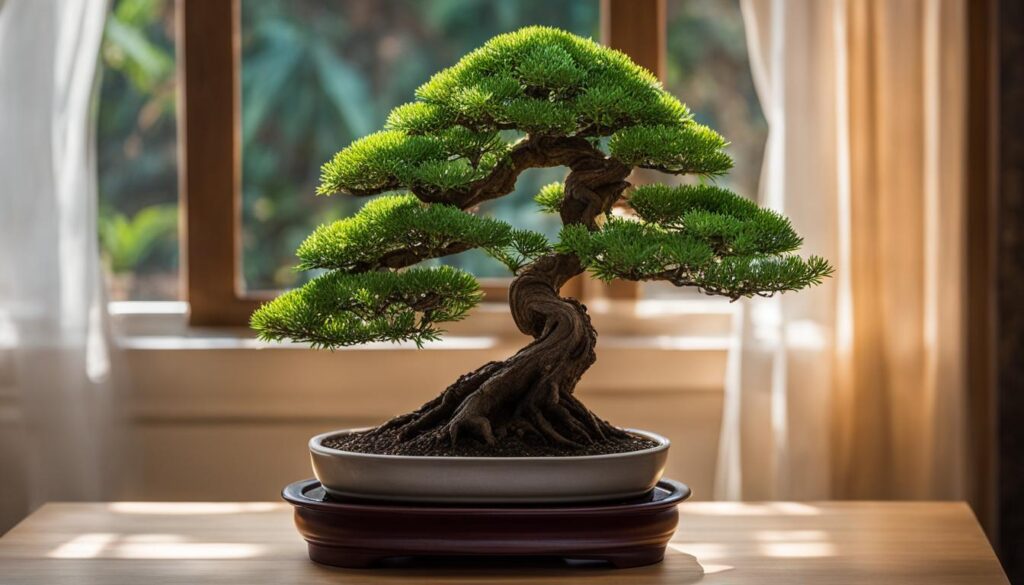
Bonsai trees are unique in their needs and require specific conditions to thrive. By understanding and meeting these special requirements, you can ensure the health and longevity of your bonsai trees. Key factors to consider include sunlight, temperature, humidity, fertilization, and pest control.
Sunlight: Bonsai trees need a balance of sunlight and shade. Some species prefer full sun, while others require partial shade. It is important to know the sunlight requirements of your specific tree species to provide the optimal lighting conditions for its growth.
Temperature: Different bonsai tree species have different temperature preferences. Some species thrive in warmer climates, while others prefer cooler environments. It is crucial to provide the appropriate temperature range for your bonsai tree to ensure its well-being.
Humidity: Bonsai trees have varying humidity requirements. Some species prefer higher humidity levels, while others can tolerate drier conditions. Understanding the humidity needs of your bonsai tree will help you create the ideal environment for its growth.
Fertilization: Regular fertilization is essential to provide the necessary nutrients for your bonsai tree’s healthy growth. Choose a balanced fertilizer specifically formulated for bonsai trees and follow the recommended application guidelines.
Pest Control: Bonsai trees, like any other plants, are susceptible to pests and diseases. Regularly inspect your bonsai tree for any signs of pests or diseases and take appropriate measures to prevent or treat infestations. Maintaining good hygiene practices and providing proper care will help keep your bonsai tree free from harmful pests and diseases.
By paying attention to these special requirements for bonsai trees, you can create an optimal environment for their growth and ensure their health and vitality. Proper sunlight, temperature, humidity, fertilization, and pest control will contribute to the beauty and longevity of your bonsai trees.
Indoor vs. Outdoor Bonsai Trees
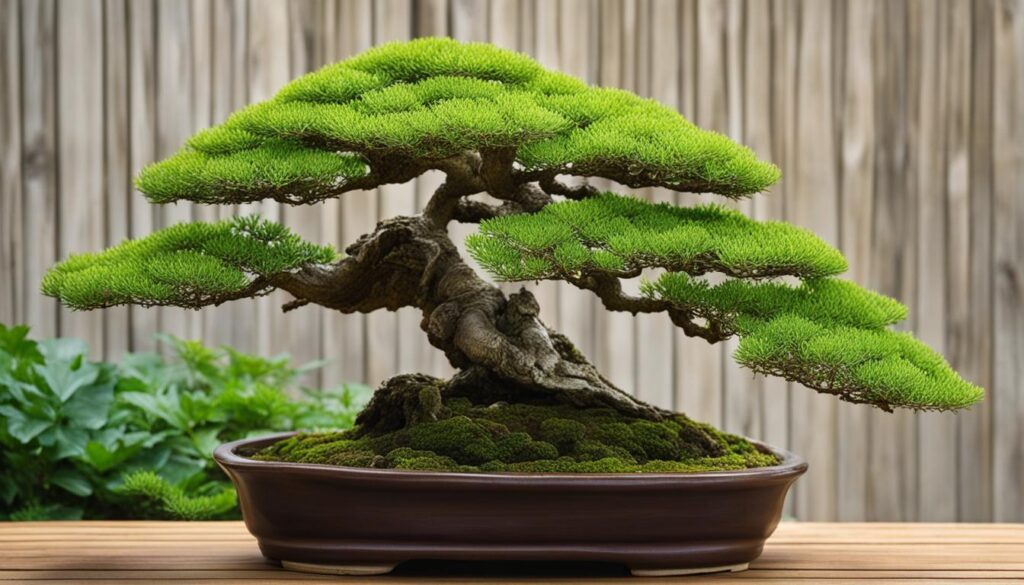
Bonsai trees can be kept both indoors and outdoors, but they have different requirements based on their placement. Understanding the differences between indoor and outdoor bonsai trees is important for their care and survival.
Indoor bonsai trees should be placed near a window with sufficient sunlight or supplemented with grow lights. This allows them to receive the necessary light for photosynthesis, which is crucial for their growth and overall health. It’s important to note that different tree species have varying light requirements, so it’s essential to research and choose the right tree for your indoor environment.
Indoor bonsai trees also require higher humidity levels compared to their outdoor counterparts. This can be achieved by placing a tray with water near the tree or using a humidifier in the room. Maintaining the right humidity level helps prevent the tree from drying out and promotes healthy foliage growth.
Protection from extreme temperatures is another consideration for indoor bonsai trees. Avoid placing them near drafty windows or areas with fluctuating temperatures. Ensuring a stable temperature range will help maintain the bonsai’s health and reduce stress on the tree.
On the other hand, outdoor bonsai trees should be chosen based on the local climate and placed in well-lit areas with appropriate sun exposure. Some species thrive in full sun, while others prefer partial shade. It’s crucial to consider the climate and weather conditions of your region to select bonsai trees that can withstand the outdoor environment.
Outdoor bonsai trees benefit from natural airflow, which helps strengthen their branches and prevents the development of fungal diseases. Positioning them in locations with good air circulation is essential for their overall well-being.
Bonsai Styles
Bonsai trees offer endless possibilities in terms of artistic expression and personal preference. There are two main categories of bonsai styles: traditional styles and modern styles. These styles showcase the diverse techniques and interpretations that bonsai enthusiasts can embrace to create their own unique miniature landscapes.
Traditional Styles
The traditional bonsai styles are rooted in centuries-old Japanese aesthetics and aim to recreate the natural growth patterns of trees in miniature form. These styles include:
- Chokkan (Formal Upright): This style features a straight, upright trunk with branches that gradually decrease in size as they ascend.
- Shakan (Slanting): In this style, the trunk has a distinct slant, often giving the impression of a tree growing on a hillside.
- Moyogi (Informal Upright): Moyogi trees have sinuous, curving trunks that add a sense of movement and elegance to the composition.
- Fukinagashi (Windblown): This style portrays the effect of strong winds on a tree, with branches and foliage leaning to one side.
- Kengai (Cascade): Kengai bonsai have a cascading trunk that creates a dramatic effect, resembling a tree growing on a cliff or over a waterfall.
These traditional styles require meticulous care and precise pruning to maintain their intended form and capture the essence of nature in miniature.
Modern Styles
Modern bonsai styles, on the other hand, offer a departure from strict adherence to natural growth patterns and embrace more abstract and artistic interpretations. This experimental approach allows bonsai enthusiasts to push the boundaries of tradition and create truly unique and unconventional compositions.
The modern styles may include:
- Ikadabuki (Layered Branching): This style emphasizes layering of branches and foliage, creating a visually striking and complex composition.
- Bunjin (Literati): Bunjin bonsai exhibit an unconventional, windswept appearance with an emphasis on elegant and elongated trunks.
- Neagari (Exposed Roots): Neagari bonsai showcase intricate root systems, with exposed roots adding a captivating and dynamic element to the composition.
- Shitate (Raft): Shitate bonsai depict a tree growing horizontally, often resembling a fallen tree or driftwood.
- Kubinagashi (Literally, “head hanging”): Kubinagashi bonsai feature a distinct trunk bend, creating a sense of movement and individuality.
These modern styles allow bonsai artists to experiment with innovative techniques and express their artistic vision through unique interpretations of nature.
Common Mistakes and Challenges While Growing a Bonsai
Growing bonsai trees can be a rewarding but challenging endeavor, especially for beginners. To help you avoid common pitfalls and ensure the health and longevity of your bonsai tree, it is important to be aware of the potential mistakes and challenges you may encounter along the way.
One of the most common mistakes in bonsai tree care is over or under watering. Finding the right balance is crucial, as both excessive and insufficient watering can harm the tree. Remember to water your bonsai regularly, allowing the soil to slightly dry out between watering sessions.
Improper pruning is another mistake that can affect the growth and form of your bonsai tree. It is essential to understand the specific pruning techniques for your tree species and to prune at the right time to encourage healthy growth. Additionally, using the wrong soil can impede root development and lead to poor tree health. Ensure you use well-draining soil specifically formulated for bonsai trees.
While caring for your bonsai, you may encounter various challenges such as pests, diseases, and root issues. Vigilance is key in identifying and addressing these problems promptly. Regularly inspect your tree for any signs of pests or diseases, and take preventive measures such as using insecticidal soap or consulting with a professional if needed. Additionally, monitor the condition of the roots to prevent issues like root rot, which can be caused by overwatering or poor drainage.
By being proactive and attentive to the needs of your bonsai tree, you can avoid common mistakes and overcome challenges. Remember to provide proper care, including regular watering, appropriate pruning, and using the right soil. Stay vigilant in monitoring your tree’s health and take prompt action if any issues arise. With patience and dedication, you can enjoy the beauty and tranquility of growing your own bonsai tree.

Karen Phillips, Bonsai expert and blogger. Read more about me here



